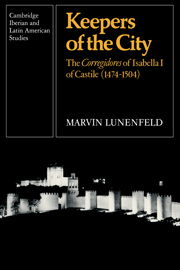Book contents
- Frontmatter
- Contents
- List of tables
- Glossary
- Map: Distribution of royal jurisdictions (1474–1504)
- 1 The omnicompetent servant
- 2 Establishing authority
- 3 The naked sword (1474–85)
- 4 Faithful servants (1485–94)
- 5 Careers open to talent: judicature, remuneration, residencia
- 6 Lords and prelates: a matter of privilege
- 7 The end of convivencia: Jews, Christians, and Muslims
- 8 Difficult governance (1495–1504)
- 9 The queen in heaven: troubled aftermath
- Notes
- Select bibliography
- Index
5 - Careers open to talent: judicature, remuneration, residencia
Published online by Cambridge University Press: 05 November 2011
- Frontmatter
- Contents
- List of tables
- Glossary
- Map: Distribution of royal jurisdictions (1474–1504)
- 1 The omnicompetent servant
- 2 Establishing authority
- 3 The naked sword (1474–85)
- 4 Faithful servants (1485–94)
- 5 Careers open to talent: judicature, remuneration, residencia
- 6 Lords and prelates: a matter of privilege
- 7 The end of convivencia: Jews, Christians, and Muslims
- 8 Difficult governance (1495–1504)
- 9 The queen in heaven: troubled aftermath
- Notes
- Select bibliography
- Index
Summary
The legal hierarchy
Whereupon the corregidor must be attentive to hear and to see with diligence the civil and criminal cases that will come under his judgement, without perverting the vara of Royal Justice; and also no one should be made corregidor who has not vanquished the passions and the cupidity for augmenting his patrimony.
Bartolomé de GóngoraThe queen made few significant innovations in the Castilian judicial system of local courts, appellate tribunals, and Royal Council, all of which were in place by the fifteenth century. At the bottom of the ladder were the trial courts of the corregidores and other judges. These tribunals also accepted appeals from the decisions of alcaldes of villages or estates. The Real Audiencia y Chancillería, at the next tier up, became so overburdened with work once it was settled at Valladolid, during the start of the reign, that a second Chancillería was created for Ciudad Real in 1494. In 1505 this new high tribunal was moved to Granada, with geographic jurisdiction between the two courts split at the Tagus River. Two lesser tribunals, denominated Audiencias, sat in Santiago and Seville to help with the growing workload.
Appeals were heard at the highest level by the Royal Council, which had judicial as well as administrative functions. There was, finally, always the last resort of a plea to the crown. Since the bulk of preserved documents concerning the corregidores deals with their close relation with the Royal Council, it is to the latter that we must turn.
- Type
- Chapter
- Information
- Keepers of the CityThe Corregidores of Isabella I of Castile (1474-1504), pp. 73 - 106Publisher: Cambridge University PressPrint publication year: 1987



